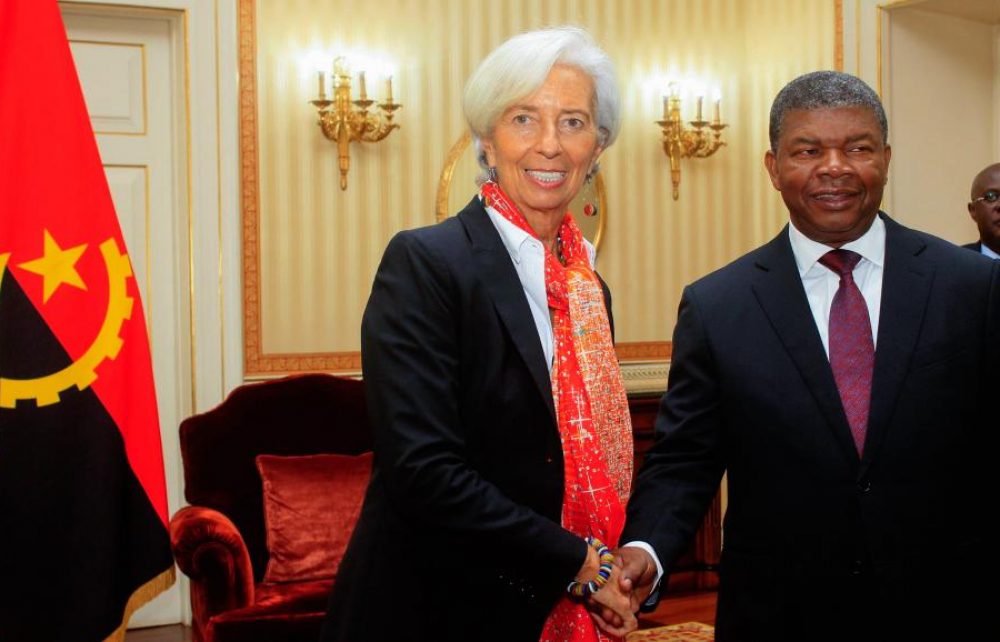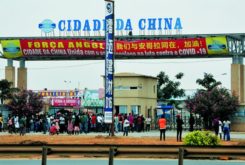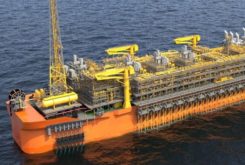With the Angolan president making public claims about the need to restructure Chinese loans, the most sizeable in the country’s foreign debt ‘mix’, the International Monetary Fund (IMF) has come in with a US$3.7 billion credit, under an Extended Fund Facility (EFF) programme. But clouds are gathering, and some EFF measures have already drawn criticism within the government and from influential sectors.
The IMF completed the First Review on 12 June, unlocking an additional US$248.15 million. The approval came with a substantial delay, with differences emerging between the IMF team and government authorities.
Among the differences looms the direction of the exchange rate, namely whether it should be determined by solely market forces or, as has hitherto been the case, managed. In January 2018, the kwanza’s value began to be fixed by the market, through central bank auctions of foreign currency to commercial banks. In that time, the Angolan currency’s value has more than halved, dropping from 185.4 kwanzas / euro to 386.542 kwanzas / euro in June 2019.
The evolution has been similar in the relation with the dollar. In the parallel market. the euro trades between 500 and 520 kwanzas. Because Angola is very dependent on imports, concerns have been mounting regarding the capacity of the country to finance acquisition of essential goods.
Inflation surged in 2018 after the exchange rate was floated and should to remain high in the short term, averaging 14.4 per cent a year, owing to continued currency weakness, according to the Economist Intelligence Unit (EIU). The weak economic picture, the EIU adds, will continue to weigh on the kwanza in 2019, with the currency depreciating further.
According to the IMF First Review, year-on-year inflation should end the year at 13.6 per cent, halving by 2021 then continuing on a steady decline.
Another issue complicating IMF-Angola relations is the state of the country’s biggest lender, state-owned BPC (Banco de Poupança e Crédito), which is being restructured but showing no improvement. A new administration has been named, and Finance Minister Archer Mangueira has publicly rejected the injection of any more state funds into the public bank, saying the government “has reached its limit.” Doubts linger about the adequacy of the restructuring plan, with calls growing for the bank to be resolved.
In the review now concluded, the restructuring of BPC is one of six new structural benchmarks added by the IMF, with a finalised plan by end-June and new management team by end-September.
While the IMF strikes a very optimistic tone regarding the policy changes (executed and expected) by the Angolan Executive branch; a few of the programme’s goals have not been entirely met.
There was “mixed progress” regarding structural benchmarks: out of four goals, only one was timely achieved; however, another was resolved in April 2019 and the remaining two are on track for completion.
External debt payment arrears also increased, while other performance criteria were met in relation to the level of Net International Reserves (NIRs), central bank (BNA) loans to the Treasury, non-oil primary budget deficit, and no issuing of oil-backed loans.
Indicative targets for the first EFF review (which set ceilings for public debt stock, payment arrears, debt reimbursements of oil-backed loans, and a floor for social sector spending) were all met, and continuous performance criteria (which include, for example, no new restrictions on international payments) were also achieved. There were also some clarifications on some criteria and the floor targets for NIRs were revised downwards, providing some extra leeway to the Angolan central bank.
One of the goals that Angola failed to meet is related with the problem of the foreign exchange (forex) backlog. Despite BNA efforts, including a ‘managed’ kwanza depreciation and forex sales directed for the amounts in backlog (as well as a considerable use of forex by the Angolan central bank, with a visible impact on international reserves), the backlog was decreased but not eliminated by December 2018, as planned in the arrangement.
Also regarding financial stability, the government did not meet the objective of revising the anti-money laundering/combating financing of terrorism (AML/CFT) law, which envisaged approval by March 2019. The Executive plans to enact the law by end-September this year, with technical assistance from the IMF. These steps are important in view of the potential lifting of the existing restrictions on correspondence banking in US dollars. Despite improvements, this should prove to be still a lengthy process, as evidenced by the latest statements by the US ambassador to Angola, Nina Maria Fite, that “there is no exact date for the corresponding banks to sell [US] dollars to Angola again.”
The IMF evaluation offers a more pessimistic macroeconomic scenario than initially expected, in the short run. The oil production drop is a major cause of concern, decisive for the economic conditions in Angola. The volatility in oil prices has also added to uncertainty.
Following the decrease in oil prices seen in the end of 2018, the Executive had mulled presenting a Revised Budget; the IMF thus required the approval of the Revised Budget as a prior action for the First Review to be concluded.
The IMF has brought their own perspectives on the economic scenario in line with the Revised Budget, anticipating GDP growth of only 0.3 per cent in 2019 (accelerating towards 2.8 per cent in 2020). This forecast is considerably more optimistic than the EIU’s, which now points to a contraction of 3.8 per cent in 2019 and 3.6 per cent in 2020.
Against a backdrop of lower economic growth, growing unemployment (28.8 per cent, up 8.8 per cent in the last two years) and higher prices, local economists and some businessmen have begun to argue against the sort of budget austerity proposed by the IMF.
According to the World Bank’s GNI per capita index, in 2014, an Angolan worker took home an average of just over US$5,000 annually. Once the oil crisis hit, that figure dropped sharply, hitting around US$3,300 by 2018.
The next phase in the programme includes critical steps, such as eliminating fuel, water and electricity subsidies, which will further increase prices for Angolan households, and decrease disposable income. Already, the introduction of a 14 per cent VAT on goods and services, set to further drive prices upward, was pushed back to 1 October.
The Entrepreneurial Technical Group (GTE) demanded the extra time to prepare but ceding it may force Angola to cut expenditures and borrow heavily to plug the US$183-million deficit created by the three-month delay.
As a way to mitigate the impact of price increases, the government’s economic council, led by President João Lourenço, approved at the end of June a set of social measures, which include a wealth-transfer programme to poorer families.




